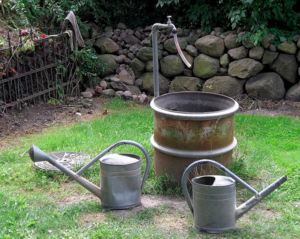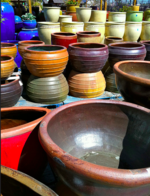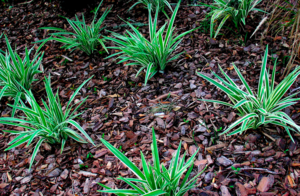
Many a gardener meets the time when conserving water becomes a premium concern in the garden. For those living in arid, dry and hot climates, this time is frequent and yearly or seasonal. Yet, even for those who live where there is plentiful rainfall and moister soils, saving water makes good sense as it still costs money to get water and it has an environmental cost whenever it is wasted or used poorly. This page is for saving the many tips and tricks that will help the home gardener save water as often, and as easily, as possible.
Choosing the right garden plants[edit | edit source]
As much as possible, choose garden plants suited to the growing area. Such plants are more likely to be accustomed to reduced levels of water or to the level of water standard for the area.
In areas where access to water is severely restricted or impossible to rely on, choose drought-tolerant plants or water-efficient plants.
- Examples of drought tolerant flowers include: Petunias,
- Examples of drought tolerant garden plants include: Succulents, pelargoniums, etc.
- If you want to keep a small lawn, choose one that is drought tolerant.
- As much as possible, switch large areas of lawn out for ground cover plants, edible garden space, native plants or such coverings as pavers or gravel.
Using suitable containers[edit | edit source]

Containers can be helpful in retaining water longer, provided the right ones are chosen.
- Glazed ceramic containers or pots hold water in for a long time.
- Plastic pots hold water in longer than terracotta. However, care must be taken to ensure that the pots don't heat up too much and stress the plant.
- Keep containers grouped together to create a micro-environment that breaks wind and disperses heat. This can help to retain water longer. It also makes watering easier and more efficient.
Selecting optimal planting positions[edit | edit source]
Follow the suggested best planting position for the species in question. This will help to reduce stress on the plant. In particular, many plants will perform better if kept sheltered from wind, which can quickly dry out the soil around the plant.
- Keep hanging baskets and wall containers away from windy areas.
- Keep shallow containers away from windy areas.
Mulching[edit | edit source]

Mulch will help to reduce water usage as it reduces evaporation considerably. As well as being useful for water retention in the soil, mulching helps discourage weed growth, improves the soil and can assist with stopping erosion. However, it can also attract the attention of birds for nest material, so be careful!
When mulching, take care not to bring the mulch to the stem, as this can cause too much moisture to be constantly around the plant and may encourage the growth of fungi or plant diseases related to moisture. Instead, keep the mulch off the actual plant; rather, place the mulch around it.
Mulch can be organic or non-organic. For example, organic materials can be pine needles, wood chips or dried grass. And non-organic materials that can work in hot and dry areas include gravel, pebbles and stones.
Using resources and tools to save watering[edit | edit source]
- Use wetting agents. Wetting agents keep soil moist for longer and increases the area of moisture across the soil space in the container or garden area where it is used. Standard wetting agents used in the home garden include water crystals or granular wetting agents. These are most effective when added at the time of planting the plant, especially within a container. Only a small amount is needed.
- Common names for wetting agents include MoisturAid, SaturAid and Hydraflo2.
- Hand water with a watering can. Carrying the watering can to and from the water source is good for building and maintaining your strength and you know exactly how much water is going onto your plants. Also, the gently trickle of water onto your plants is similar to rain, and is kind to them. Even better if your water is sourced from greywater or a rainwater tank.
- Use greywater on plants. If you can afford to put a greywater system in, or know how to make one from scratch, you can make considerable water savings directed straight at your garden for years to come.
- Consider combining watering with exercise - carry buckets from your children's bathwater to the garden. The bucket carrying strengthens your arm and back muscles, the water reusage saves water and the kids get to enjoy a bath knowing it has a dual purpose.
- Save grey water without a system in place by standing in a container when showering, using a basin to wash the dishes in, washing vegetables and fruit in a container of water, placing a bucket under hanging baskets, etc., and taking the salvaged water straight to the garden. Of course, let the water cool down if it's hot or too warm.
Irrigation methods[edit | edit source]
- Use programmable timers on fixed irrigation to avoid running it for too long. In water-restricted places, mains-fed, full power irrigation with sprinklers and sprayers, etc., is unthinkable. Drip irrigation is the way to go. (Also see greywater usage above.)
- Any irrigation system should be turned off whenever it rains. Make this a household rule that anyone who is at home when it rains is responsible for turning off the irrigation system. Be sure to turn it back on again when the rain stops. It's really a matter of habit.
Other ways to save water[edit | edit source]
- Let the lawn grow. The shorter it is, the more water it needs. Do away with a lawn altogether where water is too precious to spare.
- Work plenty of well-rotted compost into the soil. It will help to retain moisture as well as improving the soil.
- Keep plants with similar watering needs grouped together. This will help you to water them more efficiently.
- Water at the right time of day. Choose to water either early in the morning or when the sun has gone down or is no longer directly shining on your garden plants. In this way, the water will be able to penetrate the soil and won't evaporate in the sun's heat.
- If you haven't already, install a rainwater tank for home use, especially for the garden and for an emergency water supply in the event of natural disasters cutting you off from mains supplies, or in the event of drought.